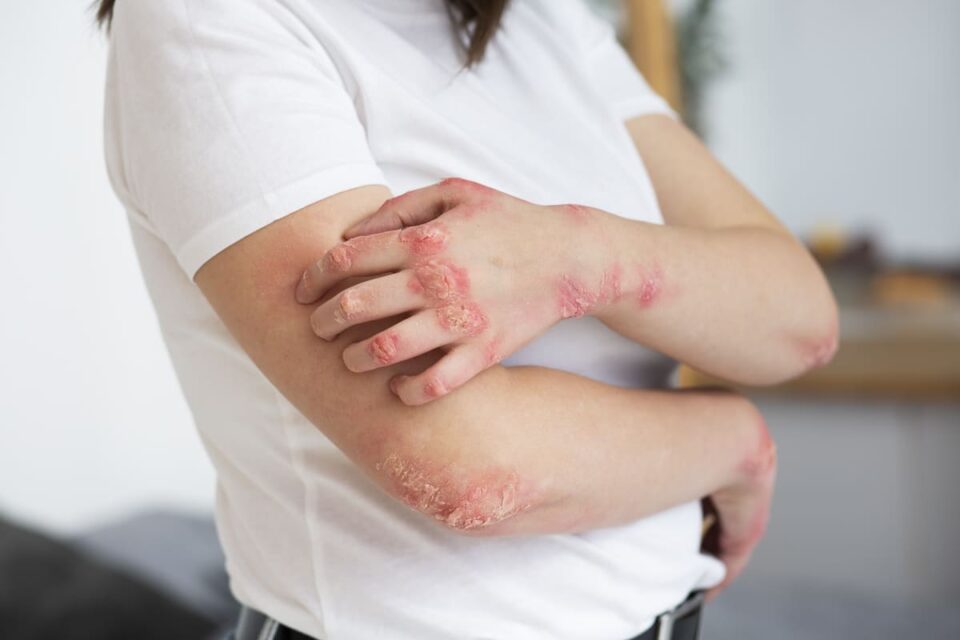Psoriasis itches, flakes, and frustrates. But why here? Why now? Red patches spread like wildfire across skin and psyche. I’ve seen it all—from software engineers to homemakers, no one is immune.
Once a relatively uncommon condition in India, Psoriasis has become a frequent visitor to my practice. But why? What’s changed in our vibrant city, causing more Bangaloreans to scratch their heads (arms and legs) over this persistent skin condition?
Let me take you on a journey through the world of psoriasis from the perspective of a doctor who’s spent years treating patients in this unique corner of the world.
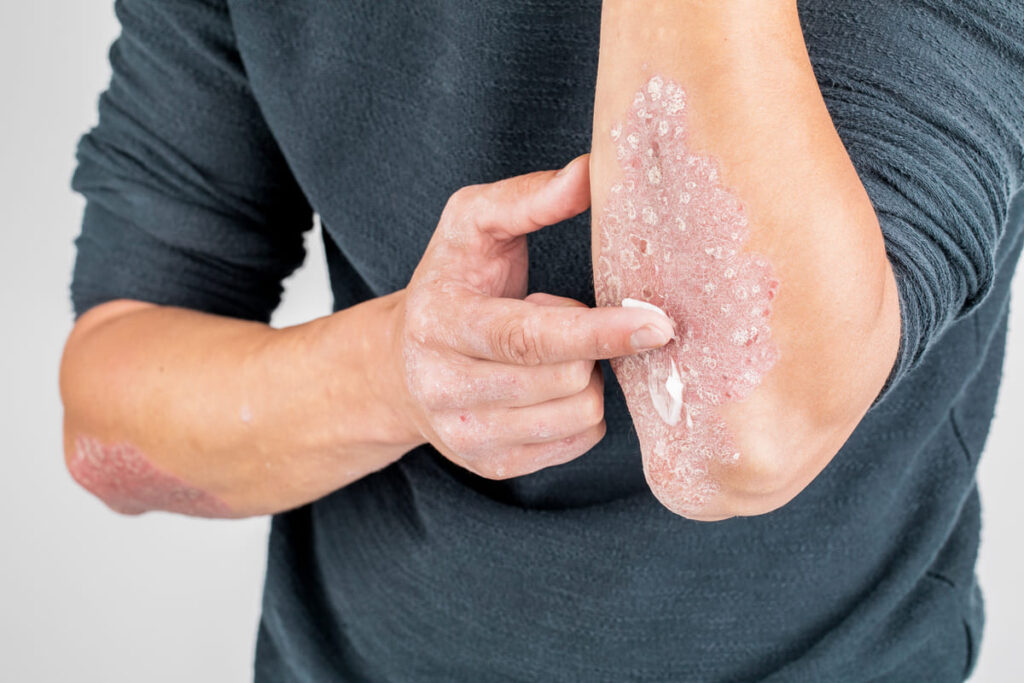
First, let’s talk about food. In a city famous for its diverse culinary scene, from traditional South Indian delicacies to trendy fusion restaurants, it’s no wonder that diet plays a crucial role in our health. But for those with psoriasis, navigating this gastronomic landscape can be like walking through a minefield in your favourite chappals.
One of my patients, let’s call him Rahul (not his real name, of course), came to me with a severe psoriasis flare-up. He was a foodie, proud of his ability to eat through every new restaurant in Jayanagar. But as I dug deeper into his diet, I realized his love for spicy, greasy foods was doing his skin no favours.
Research has shown that certain foods can trigger inflammation in the body, potentially exacerbating psoriasis symptoms. The usual suspects? High-fat dairy products, red meat, processed foods, and—I hate to say it—our beloved sugar. Yes, that means cutting back on the kesari bath, sweet pongal, gulab jamuns and ras malai, as heartbreaking as that may be.
But it’s not just about what to avoid. I always tell my patients that managing psoriasis is as much about what you add to your diet as what you take away. Foods rich in omega-3 fatty acids, like mackerel (for my non-vegetarian friends) or flaxseeds, can help reduce inflammation. And let’s not forget our local superfoods – turmeric, with its potent anti-inflammatory properties, has been a staple in Indian kitchens for centuries for good reason.
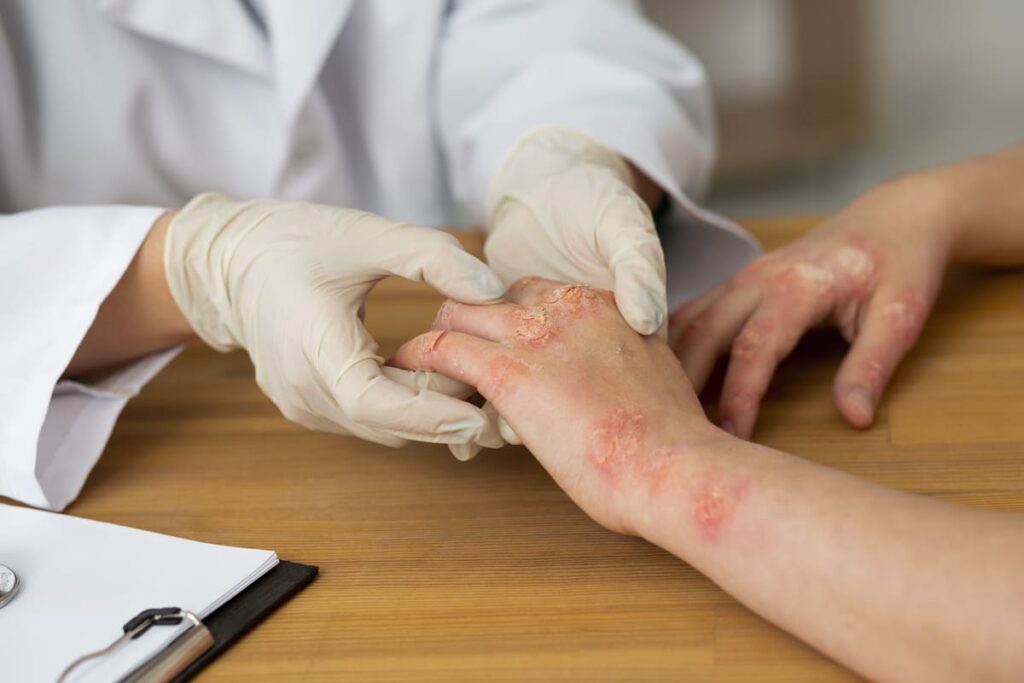
Now, let’s talk about the many faces of psoriasis. Like our diverse city, psoriasis comes in various types, each with unique characteristics. The most common type I see in my Bangalore practice is plaque psoriasis, characterized by those red, scaly patches that many associate with the condition. But psoriasis is nothing if not creative in its manifestations!
I once had a patient, a young IT professional working in Electronic City, who came to me confused about the tiny red spots covering his torso. It turned out to be guttate psoriasis, often triggered by a strep throat infection. Another memorable case was a middle-aged housewife who developed pustular psoriasis on her palms, making it painful for her to perform everyday tasks like cooking and cleaning.
These cases highlight the importance of early diagnosis and personalized treatment. Psoriasis isn’t a one-size-fits-all condition, and what works for one patient may not work for another. It’s like trying to find the perfect dosa in Bangalore—everyone has their preference, and what’s crispy perfection for one person might be too soft for another.
But why are we seeing more cases of psoriasis in Bangalore and, indeed, across India? This question has been nagging at me for years, and recent research has shed some light on this puzzling trend.
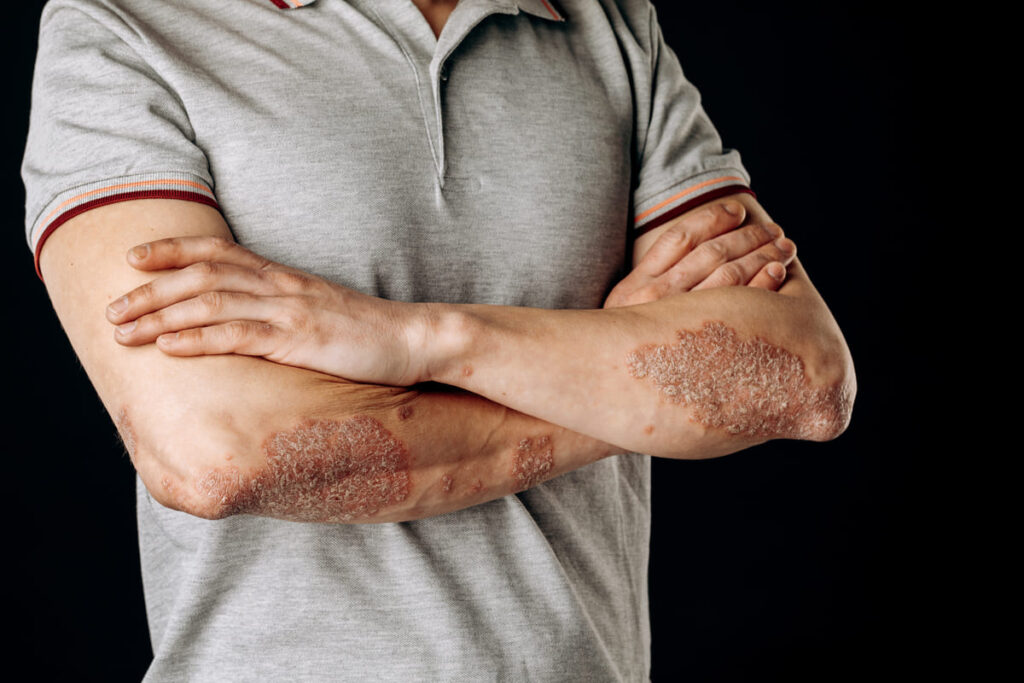
One factor could be our changing lifestyle. Bangalore has transformed from a laid-back pensioner’s paradise to a fast-paced tech hub. This change has increased stress levels, irregular sleep patterns, and a shift towards a more Western diet. All of these factors have been linked to an increased risk of psoriasis.
Pollution is another potential culprit. As our city has grown, so has the amount of particulate matter in our air. Recent studies have suggested a link between air pollution and increased incidence of psoriasis. It seems our skin is paying the price for our rapid urbanization.
But it’s not all bad news. The corresponding surge in research and treatment options is the silver lining to this increase in psoriasis cases. When I first started practising in Bangalore two decades ago, our treatment arsenal was limited. Now, we have various options that can significantly relieve even the most stubborn cases.
One fascinating area of research is the link between psoriasis and the gut microbiome. Scientists are discovering that the balance of bacteria in our digestive system may affect skin health. This has led to increased interest in probiotic treatments, which could potentially help manage psoriasis symptoms.
Of course, no discussion of psoriasis would be complete without addressing the emotional toll it can take. In a culture that places so much emphasis on appearance, the visible nature of psoriasis can be particularly challenging. I’ve had patients who’ve avoided social gatherings, given up wearing their favourite clothes or even put their wedding plans on hold due to their condition.
This is where I believe we, as a community, need to do better. Education and awareness are key. Psoriasis is not contagious, and those with it are not “unclean.” They’re our friends, family members, and colleagues dealing with a chronic condition that’s as much a burden on their mental health as it is on their skin.
I’m reminded of a patient, a young woman working in a multinational company, who came to me in tears. Her colleagues had been making insensitive comments about her skin, and she was considering quitting her job. We worked together not only to treat her psoriasis but also to build her confidence. The last time I saw her, she was thriving in her career and had become an advocate for psoriasis awareness in her workplace.
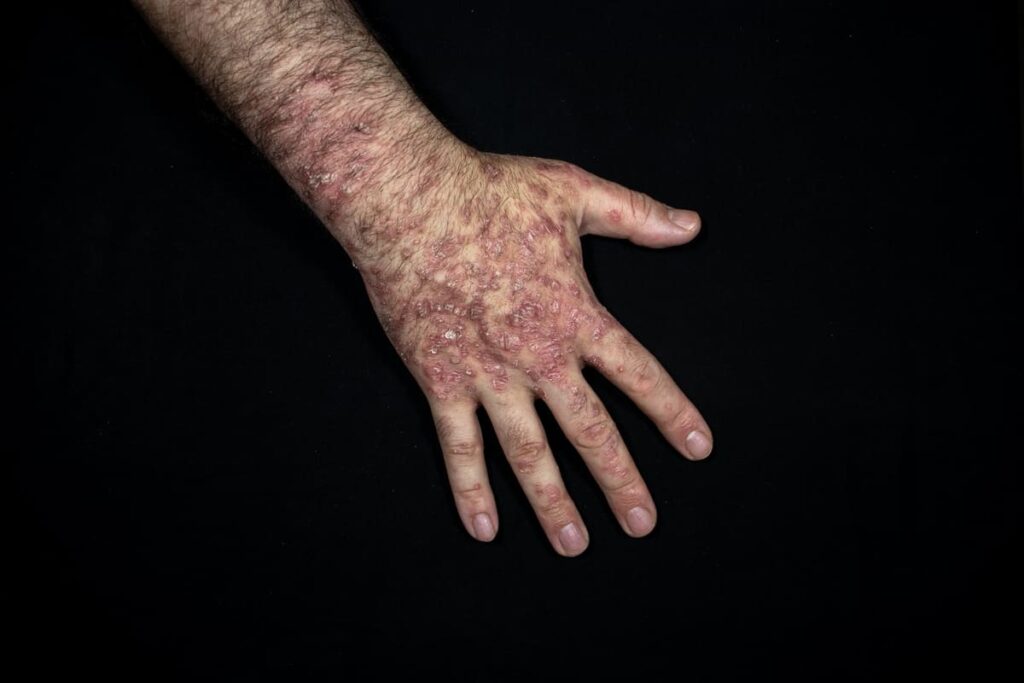
Let me share some more specific insights from my practice, mainly focusing on the psoriasis I’ve treated using Ayurvedic treatments.
Take Dimple, a 32-year-old call centre employee who came to me with severe scalp psoriasis. The constant itching and flaking had become unbearable, affecting her work performance and self-esteem. I discovered her erratic sleep schedule was a significant trigger. I saw considerable improvement in just a few months by adjusting her work hours and incorporating Ayurvedic medicines into her routine.
Then there’s Amit, a 45-year-old IT manager battling palmoplantar psoriasis. His hands and feet were covered in painful, cracking lesions, making it difficult to type or even walk comfortably. I combined traditional Ayurvedic oils, medicated ghee for oral consumption and stress-reduction techniques. Slowly but surely, he was healed completely, and Amit regained the confidence to shake hands with clients without fear.
Madhu, a 50-year-old homemaker, came to me with plaque psoriasis. Her arms and legs were covered in thick, red patches. I focused on detoxification through Panchakarma therapies and dietary changes. Cutting out brinjal, non-veg, bakery foods and incorporating anti-inflammatory foods like turmeric and ginger made a difference.
Not all cases are so visible. Karthik, a 28-year-old fitness instructor, suffered from inverse psoriasis in hidden areas like his armpits and groin. The constant friction and sweating exacerbated his condition. I introduced cooling Ayurvedic medicines and breathable, natural fabrics. His relief was palpable.
The most severe case I’ve encountered was Meera, a 60-year-old retiree with erythrodermic psoriasis. Her entire body was inflamed and scaling. It was a delicate balance of gentle Ayurvedic treatments. Progress was slow but steady. Today, Meera enjoys her morning walks in Cubbon Park without discomfort.
These cases highlight the importance of personalized treatment and the potential of combining modern and traditional approaches. They also underscore the complex relationship between psoriasis and our lifestyle choices, including diet.
Speaking of diet, let’s break it down.
Veggies: Load up on leafy greens, carrots, and bell peppers. They’re packed with antioxidants.
Fruits: Berries, citrus fruits, and apples are your friends. They fight inflammation naturally.
Grains: Opt for whole grains like brown rice and millet. They’re gentler on your system.
Packaged foods: Minimize them. They often contain hidden inflammatory ingredients.
Milk products: Low-fat options are better. Some find relief by cutting dairy entirely.
Sugar and jaggery? They’re like fuel to the fire of inflammation. Use sparingly. And let’s not forget alcohol and smoking—both are known to exacerbate psoriasis symptoms. Many of my patients have seen dramatic improvements simply by cutting back.
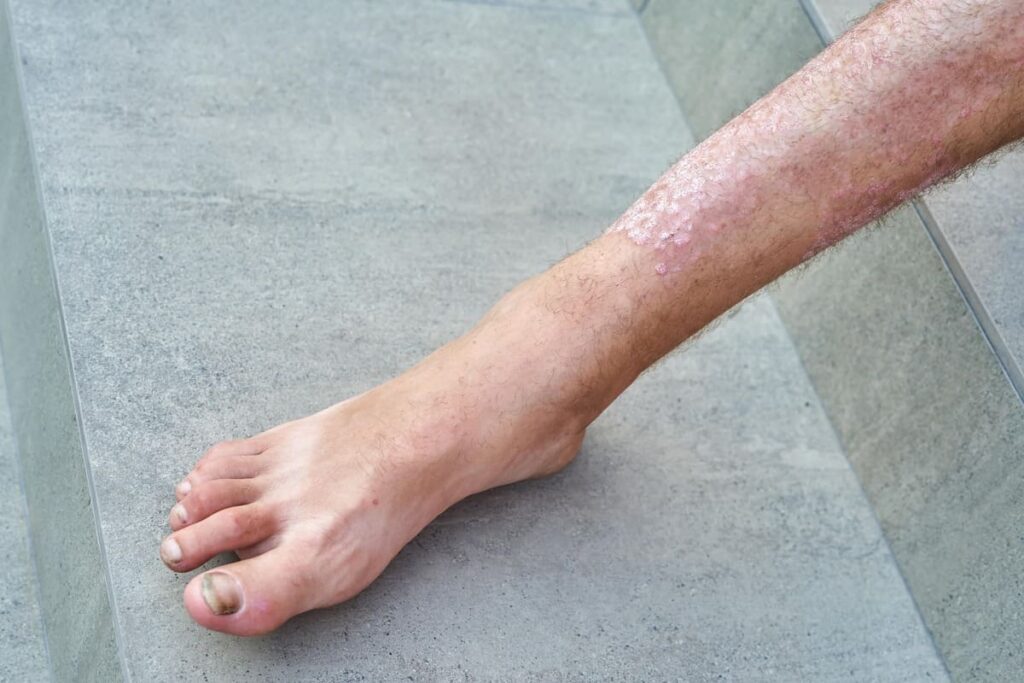
Lifestyle matters as much as diet in managing psoriasis. Take Dimple, my call centre patient. Her case showed how crucial sleep is. Why? Our body repairs itself during sleep. Poor sleep equals poor healing. Dimple’s erratic work hours worsened her psoriasis. By prioritizing sleep, she saw significant improvement. Remember, good sleep habits can be your skin’s best friend.
Psychodermatology is a new frontier in psoriasis care. It explores the mind-skin link. Stress can cause flare-ups, and flare-ups increase stress. It’s a cycle. Patients often say, “Work stress makes my skin worse.” Meditation and yoga help many find relief. These practices benefit both skin and mind, tackling psoriasis holistically.
Ayurveda identifies psoriasis as “Kitibha Kushtha” or “Ekakushtha.” Drawing from 25 years of clinical practice treating over 4,200 cases and a thorough review of approximately 80 papers, dissertations, and double-blind studies, I can attest to the effectiveness of Ayurvedic treatments for psoriasis. Combining clinical experience and research, this evidence suggests that Ayurvedic approaches often yield superior outcomes to conventional allopathic treatments in managing psoriasis. The extensive clinical trials and practical results observed over decades strongly support the efficacy of Ayurvedic methods in addressing this challenging skin condition.
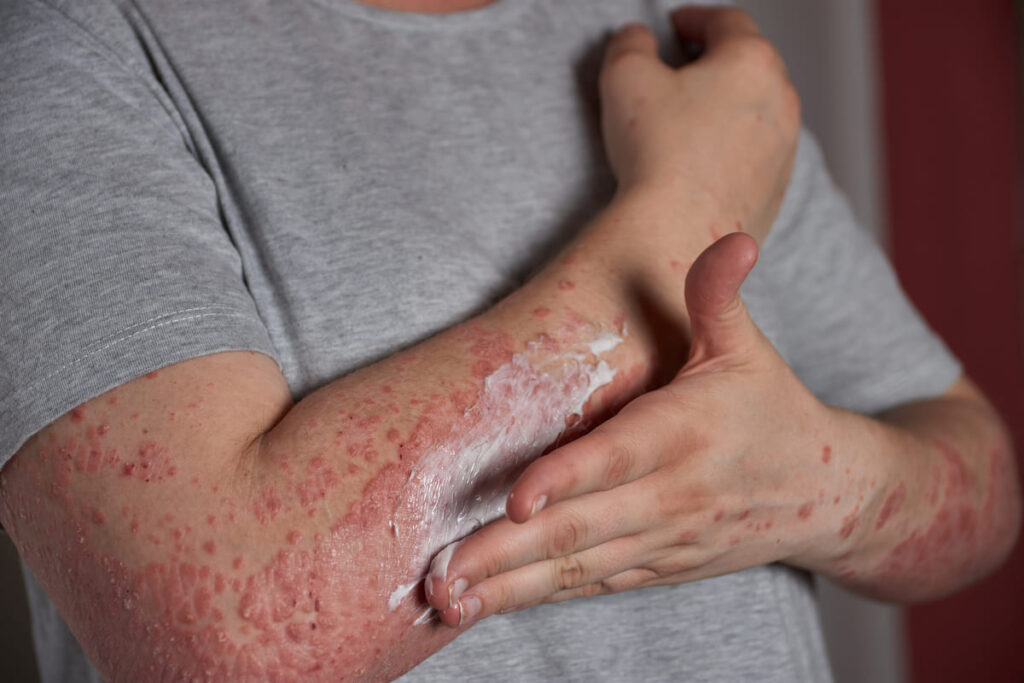
To my patients, I prescribe a trinity of healing: a fit body nurtured by the rhythm of steps or the flow of yoga; a calm mind cultivated through the stillness of meditation, the breath of pranayama, and the clarity of reflective journaling; a happy home built on understanding, mutual respect, and the lightness of not taking oneself too seriously.
Those who embraced this path found more than physical relief—they discovered holistic mind-body healing. In the face of psoriasis’s stubborn challenge, this approach offers hope.
Psoriasis wages war on skin and spirit, a relentless foe demanding more than mere medical intervention. Whether you bear its marks or witness another’s struggle, heed: knowledge is your armour, compassion is your sword. Your empathy, a balm more potent than any medicine, can soothe unseen wounds.
Healing whispers in quiet moments, a listening ear, and a nod of acceptance are good medicines. Look past the flaking skin. There, beneath the surface, a person waits. Resilient, complex, and longing to be seen, this is where true healing begins!

